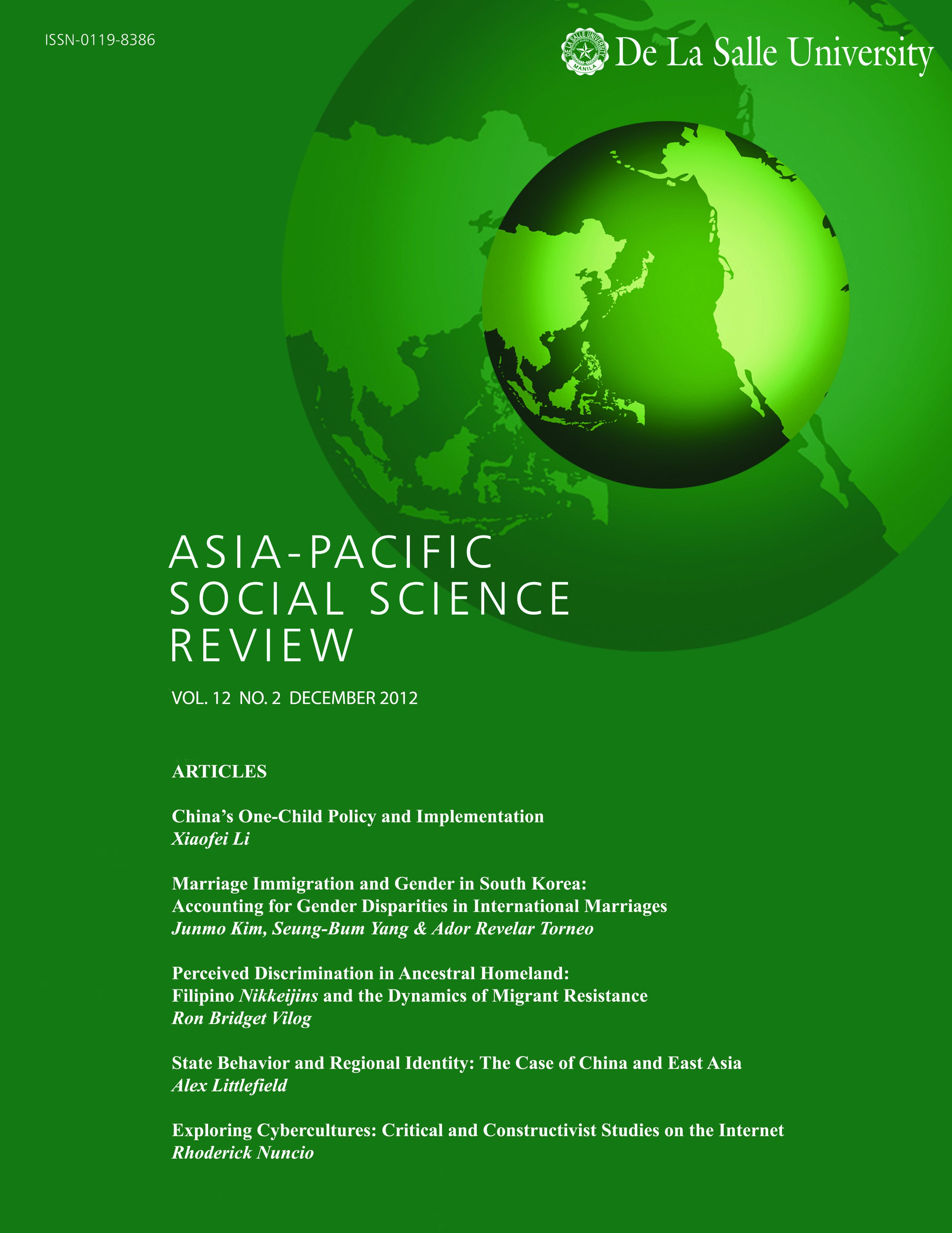APSSR Volume 12 Number 2

From the Editor
Author: Romeo B. Lee
Preliminaries
Chinas One-Child Policy and Implementation
Author: Xiaofei Li
Research Article
Pages: 1-13
Though China had been plagued by famines since ancient times, it was not until the Great Chinese Famine in the late 1950s and early 1960s that the state became proactive against future famines. In 1979, under the conviction that overpopulation was threatening China’s existence, Deng Xiaoping implemented the “one-child policy,” a coercive population control (CPC) measure intended to reduce the country’s fertility rate. However, because of the harsh nature of CPC, the disparate gender ratio that has developed, the imminent aging of China’s population, and a number of other critical enforcement concerns, CPC has proven to be far from an ideal method of population control. There have been discourses on the relevance of this policy, and its impacts on fertility decline have become debatable in the light of the subsequent economic development and social and political stability, which accounts for the fertility reduction with a changing age profile. However, the decline in fertility in China, after the improvement of the economy and higher female labor force participation rates, do not offset the need for alternative policies to the current coercive population control measures, especially the necessity for providing higher levels of education for China’s female citizens. A new policy focused upon by the Chinese government should deal more with how to address the impacts of the socioeconomic and demographic phenomenon, instead of focusing on maintaining fertility reduction. Though there are a number of suggested alternatives to the one-child policy, educating the female population is the most satisfactory and comprehensive approach.
Keywords: One-Child Policy, China, Population Control, Fertility
Marriage Immigration and Gender in South Korea: Accounting for Gender Disparities in International Marriages
Authors: Junmo Kim, Seung-Bum Yang*, and Ador Revelar Torneo
Research Article
Pages: 14-32
Recent studies on immigration in East Asia are focusing on female marriage immigration, the migration of large numbers of women from developing countries to marry men from industrialized countries like South Korea. Typically lost in the discourse however, are international marriages involving foreign grooms, once the more dominant trend in South Korea before the mid-1990s. This article explains how trends in international marriages in South Korea reversed in the mid- 1990s and how marriages involving the two genders differ in their drivers and characteristics. Both phenomena are examined in the context of neo-classical economics and push-pull theories of migration, hypergamy, homogamy, demographic transition, changing social norms, and state policies. The large scale migration of foreign brides to South Korea, or marriage immigration, is driven by demographic factors, institutionalized support, and the rise of a commercial marriage industry. Marriages involving foreign men do not share the characteristics of marriage migration, its drivers are less clear, nor is it supported by the state and Korean society.
Keywords: immigration, migration, marriage migration, marriage immigration, international marriages, gendered migration, immigration policy
Perceived Discrimination in Ancestral Homeland: Filipino Nikkeijins and the Dynamics of Migrant Resistance
Author: Ron Bridget Vilog
Research Article
Pages: 33-49
The Immigration Control Act of 1990 formally allowed the nikkeijins or descendants of Japanese nationals who were born in foreign countries to enter Japan and work without restriction. Following the rapid migration of Latin American nikkeis, thousands of Filipino nikkeijins had taken advantage of their “ethnic right” by working in Japanese factories. In spite of the privileges bestowed upon them, issues about discrimination, prejudice, and even exploitation had been reported in various fora.
This paper examines the reconfiguration of ethnic self-identification as Filipino nikkeijins face social discrimination in Japan. The narratives of second and third generation Filipino nikkeijins reveal that such experiences of prejudice and social stigma had reinforced their nikkeijin identity amidst the dominant Filipino consciousness. The study correlates the experiences of marginalization to the dynamics of migrant resistance and ethnic self-identification.
Keywords: nikkeijin, ethnicity, discrimination, identity
State Behavior and Regional Identity: The Case of China and East Asia
Author: Alex Littlefield
Research Article
Pages: 50-61
The research on East Asian multilateralism argues favorably or unfavorably over the effectiveness and durability of regional cooperation towards strengthening state-to-state relations. Those who locate cooperation (e.g. economic or security) and shared norms among Asian neighbors typically apply a liberal institutionalist or a social constructivist approach. Those who doubt the depth and authenticity of corporate spirit and goodwill towards regionalization speak in terms of traditional power politics and strategic balancing. This paper critically examines Asian regionalism using the language of social constructivism and not political realism. Ideas, identities, perceptions, and behavior are prioritized and material forces are of less concern except to the degree they influence identity. Particularly, China’s behavior will have the greatest impact, rather than current regional norms, on the viability of East Asian regionalization.
Keywords: International Relations, Security, Regionalism, East Asia, China’s Rise
Exploring Cybercultures: Critical and Constructivist Studies on the Internet
Author: Rhoderick Nuncio
Research Article
Pages: 62-71
The essay lays the sociological grounds in understanding the phenomenon of cyberculture in the age of information and communication technology. The frame of the paper is limited to constructivist and critical studies found in books and other journals. This essay particularly examines the debate on defining Internet culture and the many possible worlds and spaces it occupy in the lives of Internet users. It describes the beginning of research on the Internet and thus explains the dearth of materials in other paradigms. The paper recommends exploring other domains of interrogating the Internet as it evolves and matures through the years.
Keywords: Internet, cyberculture, Internet in the Philippines, information & communication technology, constructivism, Marxist critique of technology
Copyright @2017 De La Salle University Publishing House.

